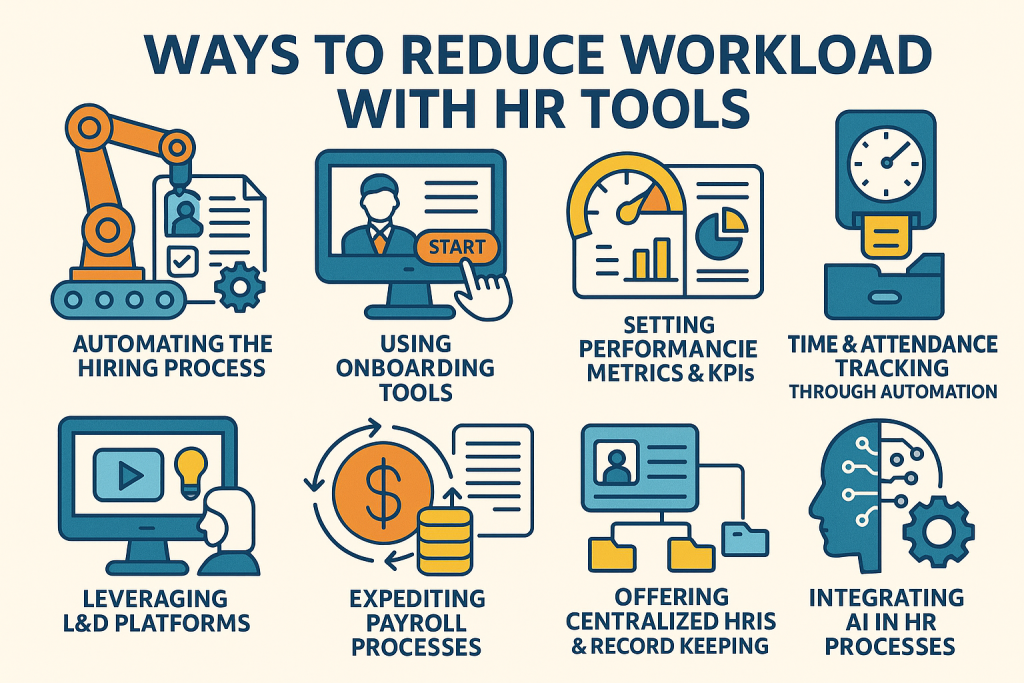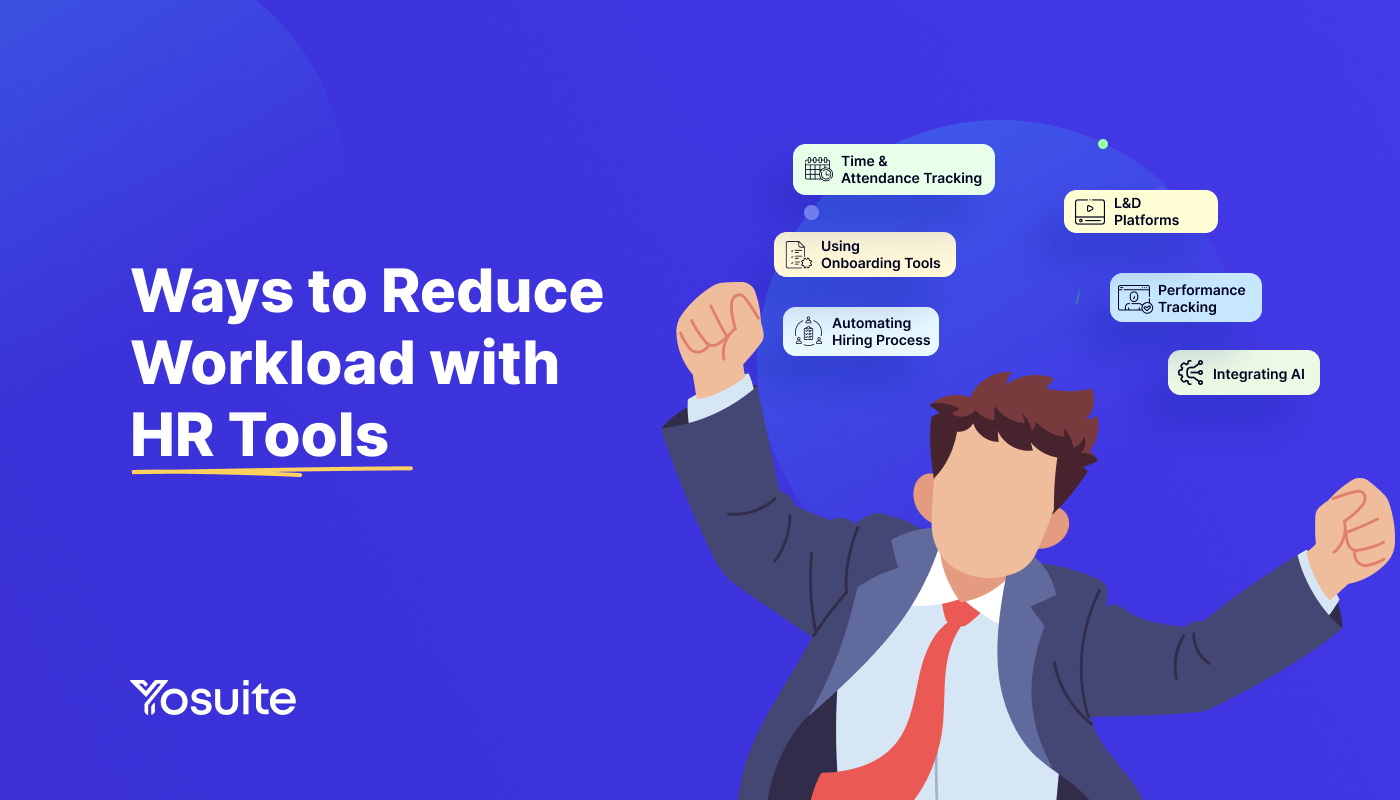As HR professionals, there are times when work drains you out mentally and physically. You feel the burden of work overload, just to ensure the organizational processes are synced. And giving the best outputs.
This may lead you to look for ways to reduce your workload. Without sacrificing on-time delivery and required quality. So, what do you do?
In today’s times, with so many tools out there, using these to reduce HR workload is the best option. But how?
This blog post will walk you through the eight effective ways to reduce HR workload using relevant tools. Let’s begin.
Table of Contents
What causes HR Workload?
There are multiple factors that culminate in work overload for HR professionals:
No proper plan and priority setting
If you do not set out a proper plan with priority for your tasks, you may need to give more time and effort to perform those. You need to develop a calendar for your annual, monthly, and weekly tasks in consultation with your supervisor. And carry them out accordingly.
For instance, if the HR department needs to recruit 20 employees for the Sales team in the next 3 months, you should prioritize the particular positions that need to be filled immediately. You can talk with the Sales Manager to know his requirements and priorities so that the job advertisements are drafted accordingly and published. on time. Or else, the whole process might become haphazard.
Lack of communication
There should always be constant and consistent communication among team members and departments. HR officials deal with employees from all departments. Thus, if you fail to keep abreast with the current situation and requirements of each department, you will fall behind. And then will have to play catch up with the work trends.

Failing to set clear goals
HR Managers and HR team members must set clear and timely goals regarding their tasks. Whether it’s regarding X no. of recruits per month or Y. no of training sessions per year, HR officials need to ensure their work targets are aligned with corporate and organizational goals.
Poor Time Management
If you do not schedule your tasks and set an approximate time for each task or goal, some tasks will adversely impact other tasks. Onboarding one particular new hire might take more time than expected. Which results in less time for other important tasks like payroll calculations.
Shortage of HR Team members
Lack of adequate resources can also lead to work overload. If one person performs payroll accounting, employee hiring, performance appraisal, facilities management, etc. then it can become a notable obstacle in getting the job done on time and efficiently. Plus, it might hinder the productivity of the HR person carrying out these tasks.
What are the effects of HR Workload?
There will be many unwanted side effects. But the most common are:
Feeling disengaged
You will start to lose interest in your work. You will feel the work is not worth your time and effort. You may want to make a switch to a new role or job.
High levels of burnout
HR employees feel burned out when too much work is exerted on them. Without the assistance of automation or proper work allocation, they get stressed out and become depressed.
Poor performance and productivity
If you cannot concentrate to your full potential and feel stressed out, your performance will automatically drop. And as your productivity drops, it will have some impact on the overall team and organizational performance. There is a good chance your poor performance can resonate with other employees.
Lack of Team collaboration
A gap in concentration and efforts can lead to a drop in team collaboration. As you feel the burden of too much work, you are always trying to wrap up your work at hand, unable to collaborate with other team members.
Search for new job(s)
The ultimate negative effect of HR workload is to look for a new job or role. When you are unable to meet deadlines, fail to ensure the HR workflows, and see a drop in performance, you will be tempted to leave your position.
Strategies to Reduce Workload and Stress

95% of HR leaders find working in HR to be overwhelming due to excessive workload and stress. A staggering 84% of HR leaders frequently experience stress, and 81% report feeling burnt out. (Sage, The changing face of HR in 2024).
This stat itself is an alarming signal for HR professionals worldwide. So without further ado, let’s look at the top modern remedies to overwork for HR:
Automating the Hiring Process
One of the first ways to reduce workload is to adopt automated tools for the hiring process. Software like ATS (applicant tracking software) helps you track and analyze applications and shortlist the right ones. It saves you ample time when the number of applications is in the hundreds or thousands.
You can also automate other recruitment processes like interview scheduling and relevant document collection with HR tools. This reduces your workload, especially when it comes to basic tasks.
Using Onboarding Tools
Once you have recruited a new hire, you need to organize a proper onboarding process. Ensuring an effective onboarding requires substantial time investment. Especially if you are implementing IT onboarding for the new hire.
Collecting the new employee’s documents, sharing office materials (as needed), accommodating him with the office rules and systems, and setting up his devices with the help of the IT team are time-consuming tasks.
But with HR onboarding tools and automated processes, you can easily reduce the time taken. The tools help you record new employee information and share company directives and materials accordingly, in real-time. The process and relevant follow-ups get sorted effortlessly.
| Tools to Try: Rippling, WorkBright, Talmundo |
Setting Performance Metrics & KPIs
A key function of HR managers is to set the KPIs and OKRs for each employee in consultation with their team leaders. However, tracking KPIs for specific time periods, like monthly or annually, can become complicated if not done consistently.
To expedite this process and avoid unwanted errors, you can use Performance Appraisal tools to track and monitor employee progress. This will help you relieve the load of continuously tracking employee performance, and you can focus on other strategic matters.
| Tools to Try: Lattice, PerformYard, Primalogik |
Time & Attendance Tracking Through Automation
For HR, tracking employee attendance and in-out times is the most basic and important daily function. This function, primarily, determines the monthly performance and pay of an employee. So, you have to monitor and track attendance carefully and accurately.
If you make an error, it will affect the salary of the employee negatively, which might create unwanted conflict and confusion. You also may not have adequate time to monitor employees’ ins and outs in real-time.
In such cases, it is best to install an attendance system or HR software with the feature to automate the process. The attendance management system should be accessible from anywhere, so that remote employees and field forces can enter on time too.
This system will reduce your hassles of managing attendance and monitoring daily attendance.
| Tools to Try: Factorial, Jibble, Connecteam |
Leveraging L&D Platforms
Developing your employees is a major task that HR managers focus on and invest on. However, once the training needs analysis is done, and the trainees are shortlisted, HR officials need to focus on managing the training and tracking the impact of the training.
Also, sourcing subject matter experts or trainers externally can be cumbersome due to trainer’s preferences, requirements, and, many times, budget.
In such cases, you can utilize learning and development solutions that can range from platforms with preloaded courses and content to training management software.
If you can enroll your employees in online courses or webinars, it will help you work on other areas as employees learn and develop at their own time and pace. You can also use training tracking software to help you monitor the progress and effectiveness of the development initiatives.
Expediting Payroll Processes
Manually calculating wages, taxes, allowances, and deductions for hundreds of employees can be prone to error. You can process payroll faster and more accurately by using automated HR software.
These tools automatically compute pay and deductions by pulling data (hours worked, leave, bonuses) from integrated systems. This ensures paychecks are correct and on time.
A startup company that used to spend two frantic days on payroll can now finish in hours. Automated payroll minimizes last-minute scrambling and errors, and it stays up-to-date with labor laws.
Offering Centralized HRIS and Record Keeping
HR information can be scattered across spreadsheets, emails, files, documents, and filing cabinets. This makes simple tasks stressful.
A centralized Human Resource Information System (HRIS) serves as a single hub for all employee data. Rather than working with multiple files, HR staff can instantly access everything from personal details and time-off balances to performance records in one platform.
If a manager needs a turnover report or an employee asks about their remaining vacation days, the HRIS can provide answers with a few clicks. This consolidation eliminates duplicate data entry and cuts down on time spent searching for information.
Integrating AI tools in the HR Processes
AI is becoming an invaluable HR assistant by handling repetitive and time-consuming tasks. An AI-driven applicant tracking system can scan and rank hundreds of resumes in seconds, sparing HR the hours of manual review work. The HR team could start their day with an auto-generated shortlist of qualified candidates.
Similarly, AI-powered HR chatbots are available 24/7 to answer common employee questions or help with leave requests, so HR staff aren’t constantly fielding the same queries. AI tools can even help with decision-making; analyzing data to flag turnover risks or schedule gaps before they become urgent problems. This helps prevent last-minute crises, an obvious source of stress for HR.
A study found that AI automation can cut the time spent on repetitive tasks by up to 30–50%, while also helping prioritize critical issues. Eventually lowering HR’s stress levels.
| Tools to Try: Most advanced tools have some form of AI integration with them |
Factors to Consider When Reducing Workload
Number of team members at hand
There are times when, due to a lack of sufficient manpower, an employer has to assign extra work to certain employees. Especially with startups and SMEs, with a limited budget for manpower, you need to accommodate extra tasks to a limited number of employees.
Number of tasks at hand
Team members might need to complete a certain number of tasks in a stipulated time. In such cases, the workload will be there. And if the current performance of the team or company is not up to the mark, you might feel the pressure of going out of your comfort zone and performing more tasks with your best efforts.
Financial constraints
Budget is a key issue in holding back efforts to reduce stress or overload. SMBs often fail to hire or onboard resources, be it human or tech, that would automate and quicken their work processes.
Company and team goals
If you have KPIs to meet or goals to fulfill, you will have to ensure that. In such cases, work stress plays second fiddle to “attaining goals”. You can’t complain about too much workload in these times.
Final Words
HR professionals need to be on their toes daily to solve employee-related issues. Thus, their work pressure and load can be very high.
To relieve work stress and create a work-life balance, HR tools can be handy options. Integrating AI-driven or automated HR tools can also boost productivity.
So, it’s best to use these solutions and improve your work progress. Following the strategies mentioned above, you can easily ensure balanced daily work. Just keep in mind the factors and challenges of implementing these tools.



Leave a Reply